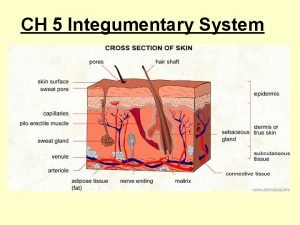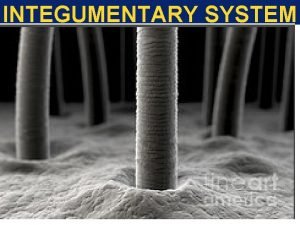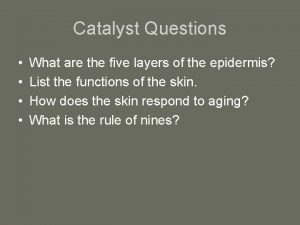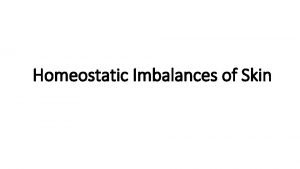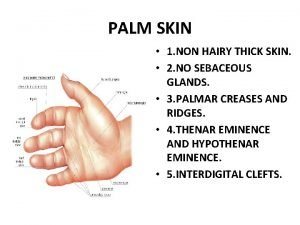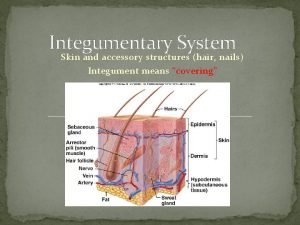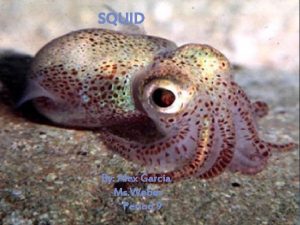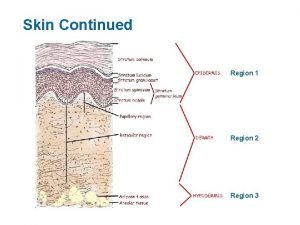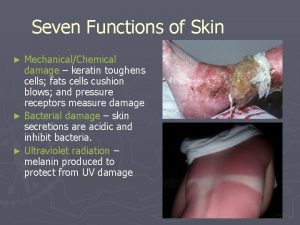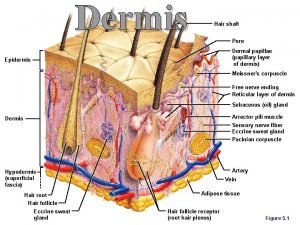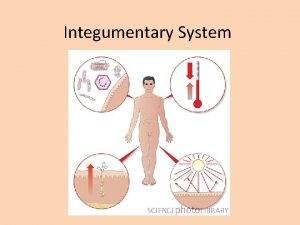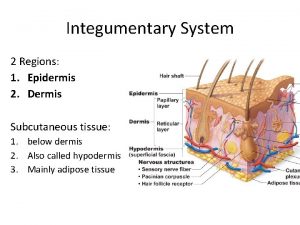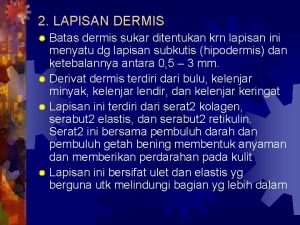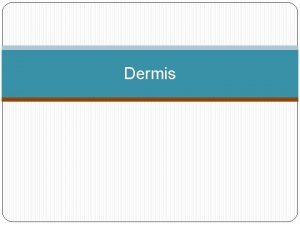Integumentary System Epidermis Dermis Hypodermis Functions of the
























































- Slides: 56

Integumentary System Epidermis Dermis Hypodermis

Functions of the skin – Barrier Water Bactericidal conditions (acid mantle, dry, oil) UV Fat-soluble vitamins can be absorbed (A, D, E, K); poisons – – Vitamin D synthesis Sensory Heat/cold Pressure Touch Texture Injury Vibration

Functions of the skin – Thermoregulation Receptors tell hypothalamus to constrict blood vessels to cool; dilate to warm the skin – Social functions – Goosebumps – piloerector muscle contracts, pulling follicle; traps air

Epidermis

Epidermis Layers (deep to superficial) – each has keratinocytes – stratum basale mitosis layer – new cells melanocytes – melanin Merkel cells – touch – stratum spinosum keratinocytes – bridge to one another by desmosomes Langerhans cells – present pathogen to immune system

Epidermis stratum granulosum – 2 -5 keratinocyte layers & waterproofing layer – grainy cell layer stratum lucidum – eleidin – immature form of keratin – clear cell layer stratum corneum – < 30 layers of cells – exfoliation/desquamate


Dermis Structures

Layers Dermis – papillary – areolar tissue; immunity Meissner’s corpuscles – pain & touch – reticular – dense irregular connective tissue Pacinian corpuscles – pressure sensor Ruffini corpuscle – stretch, heavy touch stretch marks – tears in collagen fibers

Pruney fingers The wrinkles that occur in skin after prolonged exposure to water are sometimes referred to as pruney fingers or water aging. This is a temporary skin condition where the skin on the palms of the hand or feet becomes wrinkly. In recent past the common explanation was based on water absorption in the keratin-laden epithelial skin when immersed in water; [6], this caused the skin to expand, resulting in a larger surface area and forcing it to wrinkle. Usually the tips of the fingers and toes are the first to wrinkle because of a thicker layer of keratin and an absence of hairs which secrete the protective oil called sebum. In 1935, Lewis and Pickering already found that the skin in the median nerve distribution failed to wrinkle in patients with median nerve palsy. This suggested a mechanism other than simple water absorption. Recent research shows that wrinkling is related to vasoconstriction [7][8]. Water probably initiates the wrinkling process by altering epidermal electrolyte homeostasis as it diffuses into the porous skin of the hands and soles via their many sweat ducts. Altered epidermal electrolyte homeostasis would lead to a change in membrane stability of the surrounding dense network of nerve fibers and trigger increased vasomotor firing with subsequent vasoconstriction. Vasoconstriction, through loss of volume, leads to negative digit pulp pressure resulting in a downward pull on the overlying skin, which wrinkles as it is distorted [9]. This insight resulted in bedside tests for nerve damage and vasoconstriction. For instance a patient with Diabetic neuropathy caused by Diabetes mellitus will have a different finger wrinkling pattern than a healthy subject. Wrinkling is often scored with immersion of the hands for 30 minutes in water or EMLA cream with measurements steps of 5 minutes, and counting the number of visible wrinkles in time. Not all healthy persons have finger wrinkling after immersion, so it would be safe to say that sympathetic function is preserved if finger wrinkling after immersion in water is observed, but if the fingers emerge smooth it cannot be assumed that there is a lesion to the autonomic supply or to the peripheral nerves of the hand[10].

Cutaneous Glands sebaceous - holocrine – oil ceruminous – wax of ear; cerumen – eardrum pliable, waterproofing; bactericidal mammary – modified apocrine sweat glands

Cutaneous Glands Sweat (sudoriferous) – Merocrine – most numerous water producing for coolness – Apocrine – sparse or absent in some ethnicities milky due to fatty acids scent glands responding to stress & sexual stimulation occur in groin, anal region, areola, beard in mature males still secrete by exocytosis, but larger lumen so called apocrine instead of merocrine

Dermis Structures

Hypodermis Connects dermis to muscles Subcutaneous fat

Skin coloration Normal color controlled by – hemoglobin – melanin – Carotene

Skin Discoloration 1. cyanosis – blue; low O 2 2. erythema – red; increased blood flow 3. jaundice – yellow; bilirubin buildup 4. 5. 6. 7. (hemoglobin destruction) & liver doesn’t dispose it bronzing – “tan”; Addison disease = adrenal cortex hormone deficiency pallor – pale; low blood flow albinism – white; lack of melanin hematoma - bruise

Integumentary System Review

Common Skin Disorders

Acne

Boil

Bacterial Intertrigo

Ringworm

Shingles

Warts

Tinea versicolor

Vitiligo

Psoriasis

Leprosy

Leprosy

Eczema

Poison Ivy

Uncommon skin disorders

Langerhans Cell Histiocytosis

Toxic Epidermal Necrolysis

Scleroderma

Other skin concerns Cancer – Basal cell – Squamous cell – Malignant melanoma Burns (old classification) – 1 st degree – 2 nd degree – 3 rd degree

Skin Cancers What is Cancer?

Learn the ABC’s! Asymmetry: half the mole looks different from the other half Border: the edges of the mole are irregular or ragged Color: moles are non-uniform in color, and Diameter: normal moles are typically smaller than six millimeters (a quarter inch) in diameter. Melanomas are generally bigger, although recently doctors have seen melanomas between three and six millimeters in diameter.

Basal cell carcinoma

Basal cell carcinoma

Basal cell carcinoma

Basal cell carcinoma

Squamous cell carcinoma

Squamous cell carcinoma

Malignant melanoma

Malignant melanoma

Burn Classification


1 st degree burn


2 nd degree burn



3 rd degree burn


 Integumentary system the integument epidermis coloring page
Integumentary system the integument epidermis coloring page Dermis epidermis
Dermis epidermis Papillary dermal layer
Papillary dermal layer 6 functions of the integumentary system
6 functions of the integumentary system Why does the hypodermis act as a shock absorber
Why does the hypodermis act as a shock absorber Mammary gland merocrine
Mammary gland merocrine Stratum granulosum
Stratum granulosum What makes curly hair curly
What makes curly hair curly Epidermis
Epidermis Integumentary system vocabulary
Integumentary system vocabulary Fetal pig integumentary system
Fetal pig integumentary system Integumentary system adalah
Integumentary system adalah The integumentary system facts
The integumentary system facts The integumentary system exercise 7
The integumentary system exercise 7 Integumentary system vocabulary
Integumentary system vocabulary Integumentary
Integumentary The integumentary system
The integumentary system Integumentary system physical examination
Integumentary system physical examination Integumentary system analogy
Integumentary system analogy Cat integumentary system
Cat integumentary system The integumentary system
The integumentary system Integumentary system components
Integumentary system components Integumentary system effects of aging
Integumentary system effects of aging Section 36-3 the integumentary system
Section 36-3 the integumentary system Integumentary system
Integumentary system Integumentary system
Integumentary system Unit 3 integumentary system a&p chapter 5
Unit 3 integumentary system a&p chapter 5 Skin homeostatic imbalances
Skin homeostatic imbalances Dermal structure
Dermal structure Integumentary system psoriasis
Integumentary system psoriasis Whats gametes
Whats gametes Integumentary system
Integumentary system Integumentary system
Integumentary system Integumentary system cpt coding guidelines ppt
Integumentary system cpt coding guidelines ppt Palm without skin
Palm without skin Nails integumentary system
Nails integumentary system Integumentary system
Integumentary system Excretory and integumentary system
Excretory and integumentary system Squid integumentary system
Squid integumentary system Human body foldable
Human body foldable Chapter 6 integumentary system
Chapter 6 integumentary system Estrato espinoso
Estrato espinoso 2 layers of dermis
2 layers of dermis M. arrector pili
M. arrector pili What are the two layers of the dermis
What are the two layers of the dermis Papillary region
Papillary region Seven functions of skin
Seven functions of skin Stratum corneum
Stratum corneum Layer of dermis
Layer of dermis Papillary and reticular layers
Papillary and reticular layers Slide
Slide Dermal papillae
Dermal papillae Dermis
Dermis Which letter indicates the dermis?
Which letter indicates the dermis? Dermis
Dermis Estudio de la piel
Estudio de la piel Baklim
Baklim
















